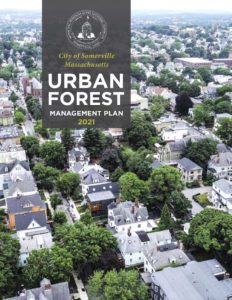Who is a member?
Our members are the local governments of Massachusetts and their elected and appointed leadership.

Somerville recently released its Urban Forest Management Plan, intended to protect existing tree health and encourage more plantings.
Following years of thoughtful planning and careful data gathering, the city of Somerville has released a comprehensive Urban Forest Management Plan.
The 359-page plan maps a path for the city to expand, preserve and maintain a healthy and diverse urban forest in order to “maximize environmental, economic, safety and aesthetic tree benefits for the Somerville community today and in the future.”
“Trees are really important to a city, reducing our heat islands and energy costs, providing habitat and cleaner air,” said Vanessa Boukili, senior urban forestry and landscape planner. “These are the quantifiable benefits. We wanted to get a handle on what we had in the city and create a road map for how to make the urban forest even better.”
The management plan includes an assessment of the city’s current inventory of public trees, a canopy cover assessment that includes private trees, and recommendations for maintaining and increasing the current urban forest over the next five to 10 years, which includes planting more public trees, improving urban forestry practices, and increasing public engagement.
“This plan is a way for us to protect the assets we’ve put in,” said Luisa Oliveira, director of public space and urban forestry. “And making sure that they survive.”
As a first step, the city worked over the course of 2017 and 2018 with Davey Resource Group to conduct an inventory of public trees, identifying 13,604 public trees in Somerville’s 4.1 square miles, with 882 additional public planting sites (containing stumps or vacant sites). Trees were catalogued by species and whether they are native or invasive. Potential threats to each species were identified.
The city has started implementing the plan, with a pruning program for young trees to make them healthier and help them live longer, and parks maintenance.
“We do hope to increase our tree maintenance and start pruning for street trees on a six- or seven-year cycle,” Boukili said. “We’ve also started planting more trees, with a goal of 350 trees per year.”
Boukili noted that the city only removes trees that are dead, dying or deemed hazardous. In the past year, a couple of big and beloved trees had to come down, she said, which sparked emotional responses within those communities.
One of the identified action items is to increase public participation and engagement with the Urban Forestry Committee to help people learn about trees and help to take care of them.
“A lot of our existing and potential tree canopy is on privately owned land, so we need to encourage residents to grow more trees and to take care of the ones they have,” Boukili said.
The city currently has 14.6% canopy cover, and has set a goal to increase it to 16%. The city assessed canopy cover by ward, and analyzed the data according to zoning classifications.
“We have some differences in canopy cover,” Boukili said. “Wards 1 and 2 are lower, which have a good number of environmental justice areas. … Having that information will help guide our choices going forward by planting in areas with less cover. We have the data to drill down even further.”
Funding to develop the plan came from the city’s budget, as well as grants from the Department of Conservation and Recreation in cooperation with U.S. Forest Service and its Urban and Community Forestry Grant Program.
“Trees are one of our solutions to climate change,” Oliveira said. “It is time for cities to give funding to inventory, planning and care, which is a challenge in small cities and towns where they just don’t have the resources.”
Oliveira and Boukili recommend that other communities interested in conducting inventories look for grant programs that can help.
“For cities and towns thinking about how to do this, maybe they can’t make a plan all in one piece,” Oliveira said, “but they can take it one step at a time.”